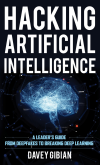Zusammenfassung
Sheds light on the ability to hack AI and the technology industry’s lack of effort to secure vulnerabilities.
We are accelerating towards the automated future. But this new future brings new risks. It is no surprise that after years of development and recent breakthroughs, artificial intelligence is rapidly transforming businesses, consumer electronics, and the national security landscape. But like all digital technologies, AI can fail and be left vulnerable to hacking. The ability to hack AI and the technology industry’s lack of effort to secure it is thought by experts to be the biggest unaddressed technology issue of our time. Hacking Artificial Intelligence sheds light on these hacking risks, explaining them to those who can make a difference.
Today, very few people—including those in influential business and government positions—are aware of the new risks that accompany automated systems. While society hurdles ahead with AI, we are also rushing towards a security and safety nightmare. This book is the first-ever layman’s guide to the new world of hacking AI and introduces the field to thousands of readers who should be aware of these risks. From a security perspective, AI is today where the internet was 30 years ago. It is wide open and can be exploited. Readers from leaders to AI enthusiasts and practitioners alike are shown how AI hacking is a real risk to organizations and are provided with a framework to assess such risks, before problems arise.
Schlagworte
Social Media Bots Google Software technology Apple Amazon Twitter Cybersecurity Machine Learning Microsoft Alexa AI Hacking Digital technology facial recognition computers national security Siri Elon Musk Jeff Bezos AI risk minimizing risk technology industry Kill Chains flaws of AI electronics cyberattacks data bias data poisoning data scientists developersKeywords
Artificial Intelligence government machines- i–x Preface i–x
- 1–10 Introduction 1–10
- 153–158 Notes 153–158
- 159–168 Bibliography 159–168
- 169–178 Index 169–178
- 179–182 About the Author 179–182

